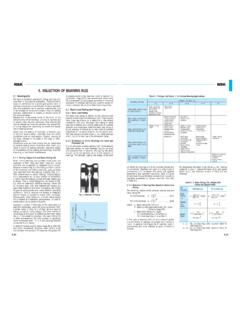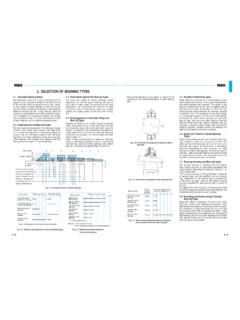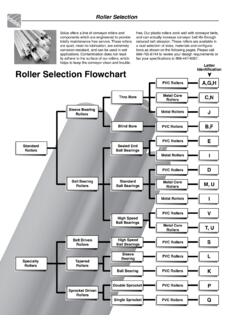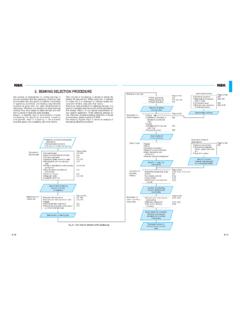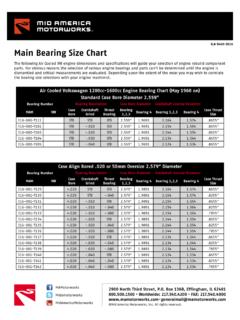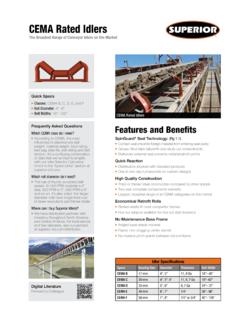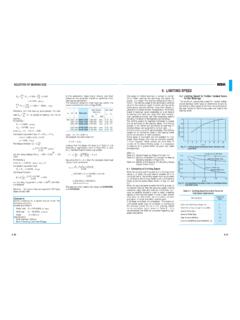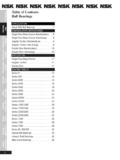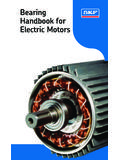Transcription of Selecting and Applying Rolling Element Linear Bearings and ...
1 Selecting and Applying Rolling Element Linear Bearings and GuidesAl Ng, Director, Engineering Rails, Guides & ComponentsRyan Thomas, Product Specialist Linear ComponentsThomson Industries, Dale, Element Linear motion Bearings are widely used to guide, support, locate, and accurately move machinery components and products in a wide range of automation applications. Rolling Element Linear Bearings and guides provide low friction, smooth, accurate motion for nearly any moment or normal loading condition. Major applications include factory automation, medical, packaging, machine tool, semiconductor, printing, automotive assembly, aerospace and food processing. Specifying the right bearing for a given application is necessary to save time and excessive costs. Understanding the tradeoffs of each bearing type is important to accurately size and select the right bearing for your application. Choosing an inadequate solution can lead to higher costs in design, surface preparation, materials, assembly, and bearing maintenance.
2 Or worse, it can lead to insufficient machine accuracy, repeatability, and life, requiring an entirely new type of Linear guide. This article will provide an overview of the major types of Linear Bearings and guides, explain how to specify them for specific applications and describe how to trouble-shoot common application of Bearings and guidesFigure 1: Comparative strengths of different bearing typesDesigners have a wide range of bearing and guide alternatives for providing accurate Linear motion. The chart above provides an overview of the advantages and disadvantages of the major types of plain contact sliding and re-circulating Rolling Element Bearings . For example, the chart shows that bronze bushings have high load capacity and low accuracy while profile rail Linear guides have high load capacity and medium Industries, Inc. 1500 Mittel Blvd Wood Dale, IL 60191 T +1-630-694-3334 F +1-630-694-3305 This article will focus on Linear Rolling Element Bearings , which are represented in the two columns on the right of the chart, because they are used in most critical industrial applications.
3 Linear Rolling Element Bearings generate much less friction than sliding Bearings so they require a much smaller motor and drive system and are capable of running at considerably higher speeds. Linear Rolling Bearings also eliminate the stick-slip effect that often causes chatter. They offer a predictable life and do not lose tolerance over their lives. Figure 2: Round rail ball bushing bearing components (Super Ball Bushing bearing shown)Round rail bearing systemThe two major types of Linear guides are round rail bushing Bearings and profile rail Bearings . A key advantage of round rail ball bushing bearing systems is their ability to accommodate torsional misalignment caused by inaccuracies in carriage or base machining or machine deflection with little increase in stress to the bearing components. The self-aligning-in-all-directions design of round rail Bearings is forgiving of poor parallelism and variations in rail height. As a result, these Bearings allow for smooth travel when mounted to wider-tolerance prepared end-supported applications, the axis of motion of round rail guides is established entirely by fixing the two ends of the shaft.
4 It doesn t matter what the surface of the machine is like between these two points or whether there is one at all. So round Linear Bearings are capable of spanning gaps up to 24 times the shaft diameter, making them useful in a range of applications such as pick-and-place modules and gantry systems. The accuracy of the guide depends only on the accuracy of the end-support precision steel round rail Bearings provide point contact on the inner and outer race so they are very low friction, and they offer a relatively lower load capacity. A more sophisticated design of round rail ball bushings offers a ball conforming groove on the outer race and maintains point contact on the inner race. This design offers a 3X increase in load capacity. An even more advanced design utilizes universal self-aligning dual tracks, offering a 6X increase in load capacity. This increase in load capacity is achieved by maximizing the load reaction between the inner and outer races. This break-through in load capacity rivals that of Linear guides while still retaining the advantages of the round rail design that enable the Linear bearing to avoid many of the derating factors that can diminish the load/life performance of square rail Industries, Inc.
5 1500 Mittel Blvd Wood Dale, IL 60191 T +1-630-694-3334 F +1-630-694-3305 Figure 3: Profile rail bearing Linear guideProfile rail bearing systemsProfile or square rail systems offer higher accuracy, higher rigidity, higher load-life capacity, and are also very compact. Their key advantage is derived from ball conforming grooves on both inner and outer races that increases load capacity relative to standard round rail guides. The ball track groove in profile rail guides is only slightly larger in radii than that of the balls themselves. The geometry cradles the balls as they infinitesimally flatten under load, slightly expanding the contact area between the balls and the races. As a result, profile-rail Bearings are roughly 10 times stiffer than a traditional round rail assembly with ball and shaft surfaces that are convex. Profile rail guides can provide positioning accuracy from inch to inch over 10 feet. Square rails can be preloaded from 3% to 13% of rated dynamic load to further reduce aspect of concern for profile rail Bearings are that mounting surfaces must be precise thus they are more difficult to install.
6 Profile rail designs are especially sensitive to flatness errors that can cause binding. Surfaces must be carefully prepared or the parts may need to be shimmed and adjusted during installation. One common rail alignment method is to mount one rail on a qualified surface against one qualified reference edge, and float the second rail into place while moving the carriages. Three other alignment methods, in order of increasing complexity and accuracy, are to establish relative position of the rails by using gauges blocks, both reference edges, or a positioning even higher rigidity or load-life capacity option is a Linear Profile Rail roller guide bearing wherein cylindrical rollers run between flat races. Interestingly, there is also a Round Rail bearing using concavex rollers running on a cylindrical inner race that offer up to 20 times that load capacity of conventional Linear ball Bearings . Round Rail Linear roller Bearings handle up to 35 tons per bearing and speeds up to 100 feet per second.
7 Their optimized contact ellipse maximizes the load capacity of an anti-friction Linear bearing . Round Rail Bearings can carry loads up to 70,000 lbs per bearing at a 10 million inch rated travel Industries, Inc. 1500 Mittel Blvd Wood Dale, IL 60191 T +1-630-694-3334 F +1-630-694-3305 Figure 3b: Roller rail Bearings offer increased load capacity over ball profile rail Bearings as a result of increased contact surface. Machine builders can downsize from a typical ball profile rail assembly to a smaller roller assembly without compromising load Thomson 500 Series Roller bearing Assembly achieves superior rigidity by use of 45 contact angles, a back-to-back arrangement and crowned rollers to prevent edge loading in case of any of the 500 Series Ball bearing Assembly can include reduced stiffness, drag and simpler of Linear Bearings and guidesThe sizing and selection process is similar but not exactly the same for round and profile rail Bearings . Loads acting on Linear Bearings and guides can be vertical loads, horizontal loads or pitch roll or yaw moment loads, or any combination thereof.
8 Loads may also vary in their magnitude and direction. A resultant load vector at each bearing must be established from the combination of the various load vectors to which the Linear bearing system is subjected, as life expectancy cannot be estimated based on just the system load vectors. The load under which each Linear bearing is subjected is called the dynamic equivalent load for that given bearing . The system is then sized based on the most heavily loaded bearing . For more information on computation methods for a dynamic equivalent load, refer to the Linear bearing and guide suppliers 4: Determining effect of load directionFor a round rail bearing , the dynamic load rating is based on a load at top dead center. However, the actual bearing load capacity is dependent on the direction at which the load is applied. So a delimiter or direction factor must be applied to the rated load based on the actual polar direction at which the load is applied. Refer to the proper Polar chart for the product, similar to Figure 4, to determine the Thomson Industries, Inc.
9 1500 Mittel Blvd Wood Dale, IL 60191 T +1-630-694-3334 F +1-630-694-3305correct K , direction factor. Find the angle at which the load is applied relative to the bearing , and move in radially along that line until it intersects the curve shown in Figure 4. Move around circumferentially to the polar correction values located on the vertical axis. Multiply the dynamic load capacity listed in the product specification table by the proper polar correction factor to adjust the load rating for load direction. You can perform a load-life calculation using the following formula:USmLKKPWL =3)( Lm = travel life in inches or kmW = dynamic loading rating in lbs or NP = applied equivalent load in lbs or NK = load direction factorKS = shaft hardness factorLU = 100 km or 2 X 106 inchesFor Profile rail Bearings and guides the equivalent loads to which the Bearings are subjected are determined by the same method used for round rail Bearings and guides. Load direction calculations, however, are not required because these Bearings and guides have the same load capacity in all directions.
10 The following formula is used for load/life calculations:kmPWLnm100)( =Where: Lm = travel life (km)W = dynamic load rating (lbs or N)P = applied equivalent load (lbs or N)N = 3 for all guides, 10/3 for roller guidesTwo-rail systems are generally advised for most applications because more favorable load distributions between the Bearings can be achieved, and self-alignment is possible with most Round Rail Bearings . One-rail systems can be used in certain applications where envelope restrictions are tight. In these cases, profile rails are recommended to address pitch, yaw and roll moment load requirements. The use of three or more rails, or Bearings per rail, is typically discouraged because of potential over-constraint, and equal load sharing between the Bearings would be difficult to achieve. In addition, the use of three or more rails, or Bearings per rail may shorten system life if they are not perfectly matched and bearing accuracyLinear bearing accuracy is defined as the variation in height over the length of the travel.








